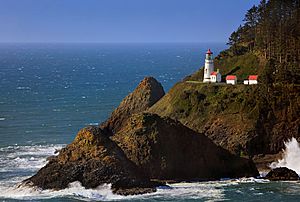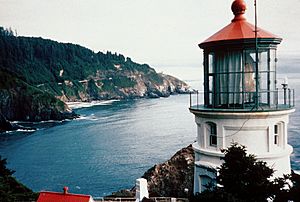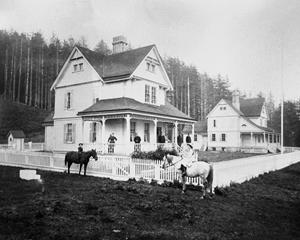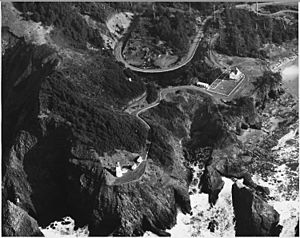Heceta Head Light facts for kids
 |
|
| View of Heceta Head Light showing Heceta Head | |
|
|
|
| Location | Heceta Head, Florence, Oregon |
|---|---|
| Coordinates | 44°08′15″N 124°07′40″W / 44.13737°N 124.127835°W |
| Year first constructed | 1892 |
| Year first lit | 1894 |
| Automated | 1963 |
| Foundation | Natural/emplaced |
| Construction | Brick/stuccoed |
| Tower shape | Conical attached to workroom |
| Height | 56 feet (17 m) |
| Focal height | 205 feet (62 m) |
| Original lens | First order Fresnel lens |
| Range | 21 nautical miles (39 km; 24 mi) |
| Characteristic | Flash white, 10 seconds |
The Heceta Head Light is a famous lighthouse on the Oregon Coast in the United States. It stands tall on a 205-foot (62 m) cliff called Heceta Head. This lighthouse was built in 1894 and is 56 feet (17 m) tall.
Its powerful light can be seen from 21 nautical miles (39 km) away. This makes it the strongest light along the entire Oregon Coast. The lighthouse is part of the Heceta Head Lighthouse State Scenic Viewpoint, a state park.
The Oregon Parks and Recreation Department takes care of the lighthouse. The old house where the assistant lighthouse keepers lived is now a bed-and-breakfast inn. The United States Forest Service manages this house. The lighthouse is also very close to the famous Sea Lion Caves.
Contents
Exploring Heceta Head's Past
Heceta Head gets its name from Bruno de Heceta. He was a Spanish explorer who explored the Pacific Northwest in the late 1700s. Before settlers arrived, this area was important to the American Indian tribes, especially the Siuslaw people.
They called the area ɫtúwɪs. They often hunted sea lions and collected seabird eggs from the rocks nearby. There is also a legend about the Animal People building a great stone wall, which are now the cliffs. They tricked the Grizzly Bear brothers to their deaths there.
Building the Lighthouse
In 1888, new settlers moved into the area. The United States Lighthouse Service decided to build a lighthouse here. The government bought 19 acres of land for the lighthouse and its buildings.
Construction began in 1892 with a team of 56 workers. Getting building materials to this remote spot was hard. They either shipped materials by sea when the weather was good or brought them by wagon from Florence, Oregon. This wagon trip usually took four or five hours.
Stones came from the Clackamas River, and bricks were shipped from San Francisco. The special lens system was made by a company called Chance Brothers. The lighthouse was finished in August 1893.
What Was Built?
The entire project included several important buildings:
- The lighthouse tower itself.
- Houses for the head lightkeeper, the two assistant lightkeepers, and their families.
- A barn for animals and supplies.
- Two separate buildings to store kerosene oil. This was a safety measure in case one caught fire.
Lighthouse Life and Changes
The Heceta Head Light and Keepers Quarters was added to the National Register of Historic Places in 1978. This means it's an important historical site.
Originally, there were more buildings, including a larger house for the head lighthouse keeper. This house was taken down in 1940. It was very similar to the house that still stands today.
The Keepers' Homes
After electricity came, the head lighthouse keeper was no longer needed. His house was sold for a small amount and taken apart. Its wood was used to build a bookstore-cafe in Mapleton, Oregon, which is still there.
The house that remains was a duplex. This means it had two separate living spaces. The first and second assistant lighthouse keepers and their families lived there.
Automation and Restoration
In 1963, the lighthouse became "automated." This means machines took over the job of keeping the light running, so human keepers were no longer needed. The last keepers moved away.
The remaining house was later leased to Lane Community College in 1970. The United States Forest Service took over managing the building. The porch of the house, which is in the Queen Anne style, was repaired in 1981.
The Heceta Head Lighthouse closed in August 2011 for major repairs. A team of over 100 workers, mostly from Oregon, worked on it. They removed old cement that was trapping moisture inside the lighthouse. They also fixed the metalwork and brick, put in new windows, and repaired the lens's spinning system.
The inside and outside of the lighthouse were repainted. The original wood floor in the workroom was uncovered and fixed. The goal was to make the lighthouse look as much as possible like it did in 1894. It reopened on June 8, 2013, after two years of work.







